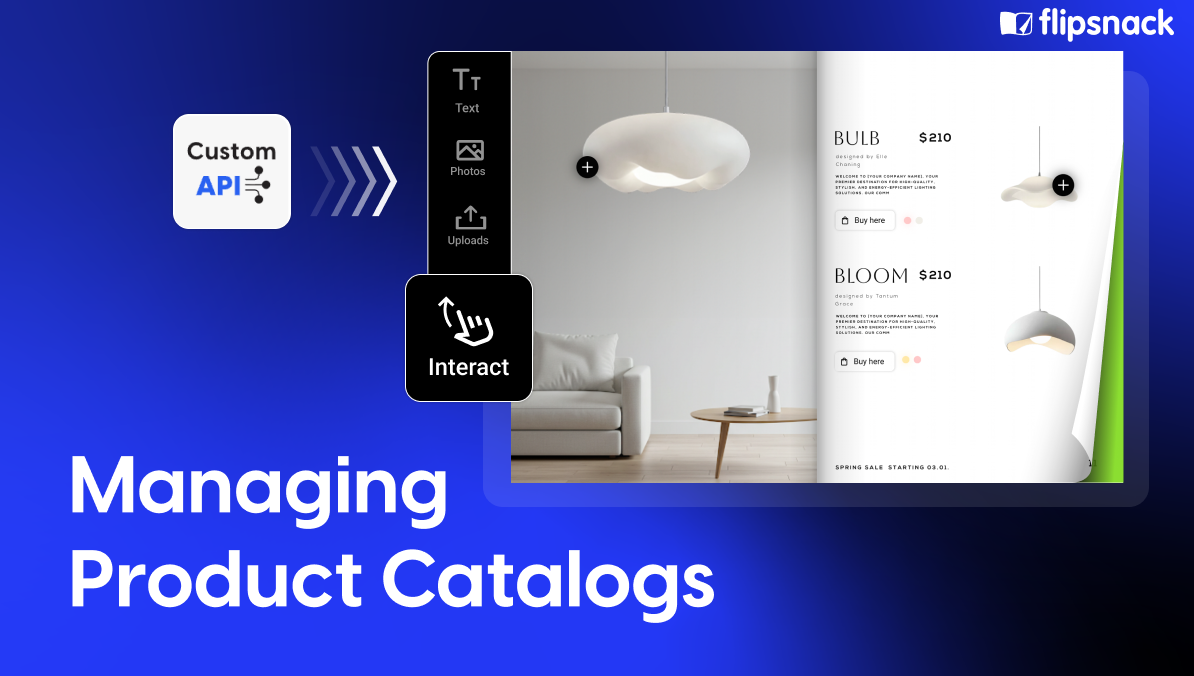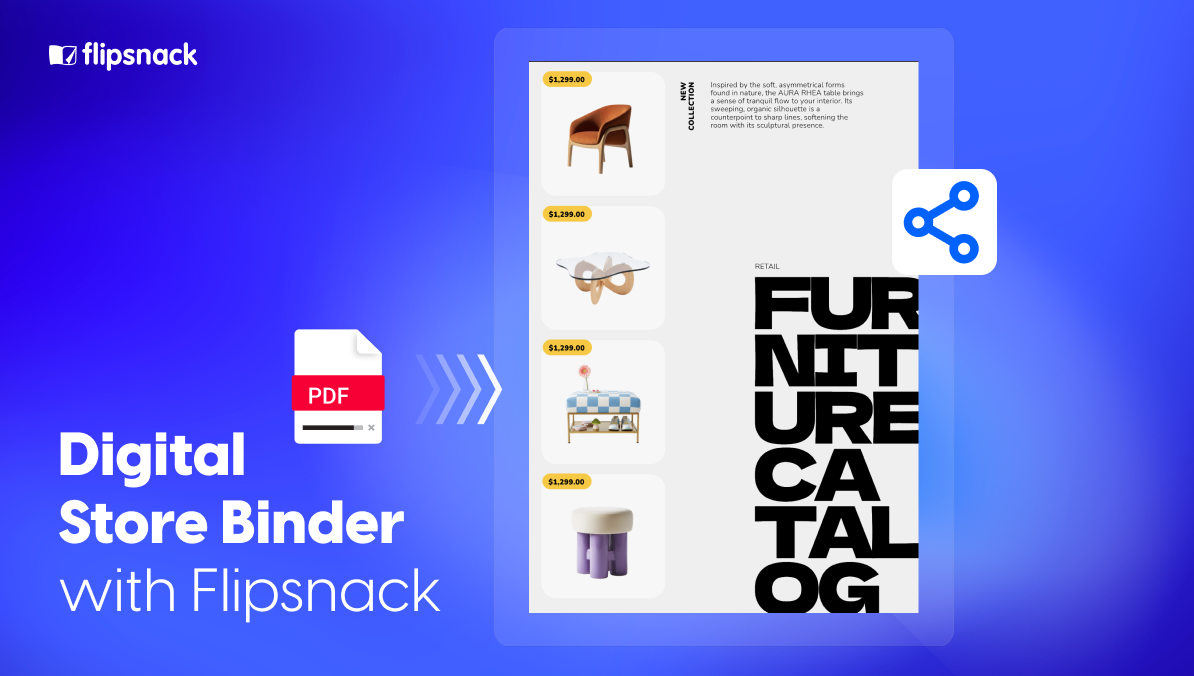Digital catalog management optimization: Integrations & automation
In today’s fast-paced digital landscape, efficiency is key to staying competitive. That’s why digital catalog management optimization is needed from being a convenience to an absolute necessity. Whether you’re a retailer managing product listings, a B2B company capturing leads, or a marketing team tracking customer engagement, automating your catalog processes can revolutionize your workflow and drive better results.
By automating repetitive tasks and reducing manual errors, you not only save time but also ensure that your digital catalogs remain, up-to-date and accurate, giving you a competitive edge in today’s fast-paced market.
Pick your challenge. Get a tailored solution.
But automation alone isn’t enough. To optimize your workflow, you also need integration, which connects different tools and platforms to work efficiently together. For businesses creating digital catalogs, combining automation and integration can transform how you manage, update, and interact with your catalogs, providing accuracy at every step.
So, what exactly do automation and integration mean for your digital catalog, and how can a tool like Flipsnack help streamline your processes? Let’s dive in.
Table of contents
- What is automation for your digital catalog?
- Case Study: Pandora France boosts store efficiency with automated catalogs
- How automation and integration tools simplify catalog management
- Choosing the right integration tools for digital catalog management
- The benefits of integration and automation for your digital catalog management
- Integration with Zapier through Flipsnack
- 3 ways to use Zapier to help you streamline your selling process
- Frequently asked questions
What is automation for your digital catalog?
Automation refers to using technology to handle tasks that would typically require manual effort. For creating a digital catalog, think about tasks like updating product information, syncing new data, and distributing, these are often repetitive and time-consuming. Process automation simplifies these processes by making sure your catalog is always up-to-date with the latest product details, without you having to manually input the data each time.
Automation matters, because businesses managing large catalogs with hundreds or even thousands of products, manually updating every change is simply not efficient. Digital catalog management optimization through automation ensures your catalog updates instantly whenever a product price changes, inventory runs low, or a new product is added. This not only saves you time but also helps avoid expensive mistakes that can happen with manual data entry, especially when your product data is supported by reliable inventory management software that keeps stock information accurate in real time.
A tool like Flipsnack allows you to turn PDFs into interactive catalogs, and you can make these updates in seconds. The provided automation feature lets you import all the information from your products in the form of CSV, Excel, or spreadsheet and automatically populate your catalogs, saving you significant time and effort.
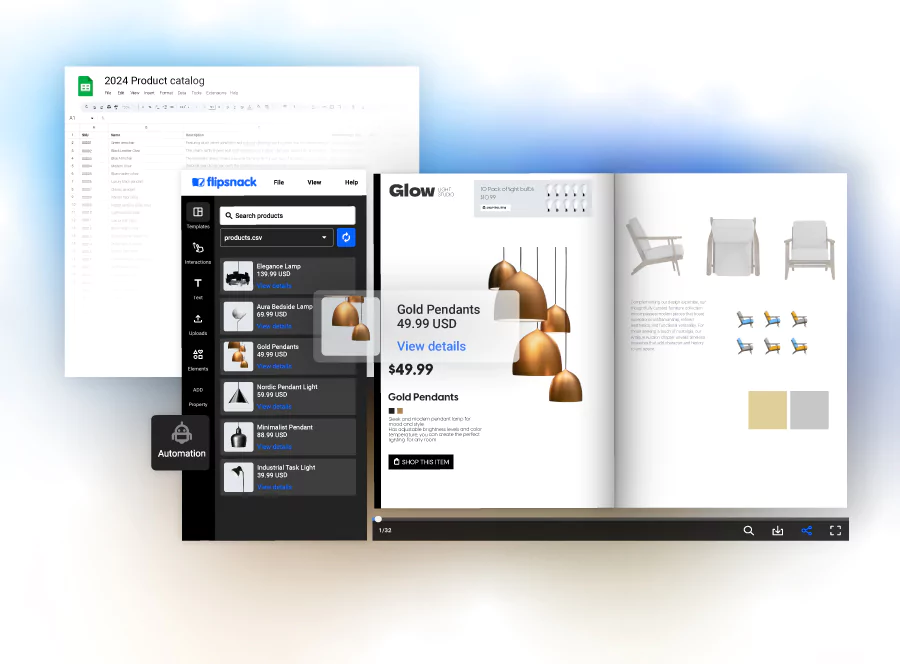
Case Study: Pandora France boosts store efficiency with automated catalogs
On this side, Pandora France shows its impact in retail. With 130 stores across France, Pandora replaced printed PowerPoint catalogs with interactive, automated Flipsnack catalogs.
By using Flipsnack’s Catalog Generator, Pandora’s Retail Excellence Team now imports product data directly from Google Sheets into branded templates. Updates happen once in the database, and new catalogs are instantly generated with the latest product details, no manual editing required. A single QR code connects store staff and customers to the most up-to-date version.
Store teams benefit from barcode-enabled catalogs that cut product lookup times by 3x, while customers browse interactive catalogs on their own devices, complete with engraving options and real-time collection updates.
Now, we update the catalogs once, and it’s instantly available everywhere. Store staff just scan and see the latest version.
Carla Michel d’Annoville
Pandora’s Retail Excellence Team
How automation and integration tools simplify catalog management
Automation tools are crucial in simplifying your digital catalog management by handling repetitive tasks without human intervention. These tools can:
- Automatically update product information, prices, and inventory levels
- Generate and update product descriptions
- Schedule catalog publications and updates
- Create and manage product categories
For example, an automation tool might automatically pull updated pricing information from your database and apply it to your digital catalog. This way, your prices are always up to date. Digital catalog management optimization involves choosing the right integration tools and adhering to best practices, such as those outlined in the dbt Labs style guide, to ensure consistency and efficiency.
Choosing the right integration tools for digital catalog management
While automation handles repetitive tasks, integration connects different tools and platforms to create a unified workflow. For example, integration allows your digital catalog to sync directly with your product management systems, CRMs, marketing tools, or a software localization tool. By combining automation with integration, you can create a system where updates happen automatically and are reflected across all of your platforms seamlessly.
And to successfully implement integration and automation for your flipbooks, it’s essential to choose the right tools. Here is what to consider to make sure you are making a good decision:
- Compatibility: ensure the integration tools you select are compatible with your existing systems and platforms.
- Scalability: choose tools that can grow with your business, accommodating future needs and additional integrations.
- User-friendly interface: opt for tools that are easy to use and require minimal training for your team.
- Good customer support: look for tools backed by strong customer support and an active user community for troubleshooting and best practices.
By carefully evaluating these factors, you can make sure that the integration tools you choose will not only meet your current needs but also support the future growth and efficiency of your flipbook.
The benefits of integration and automation for your digital catalog management
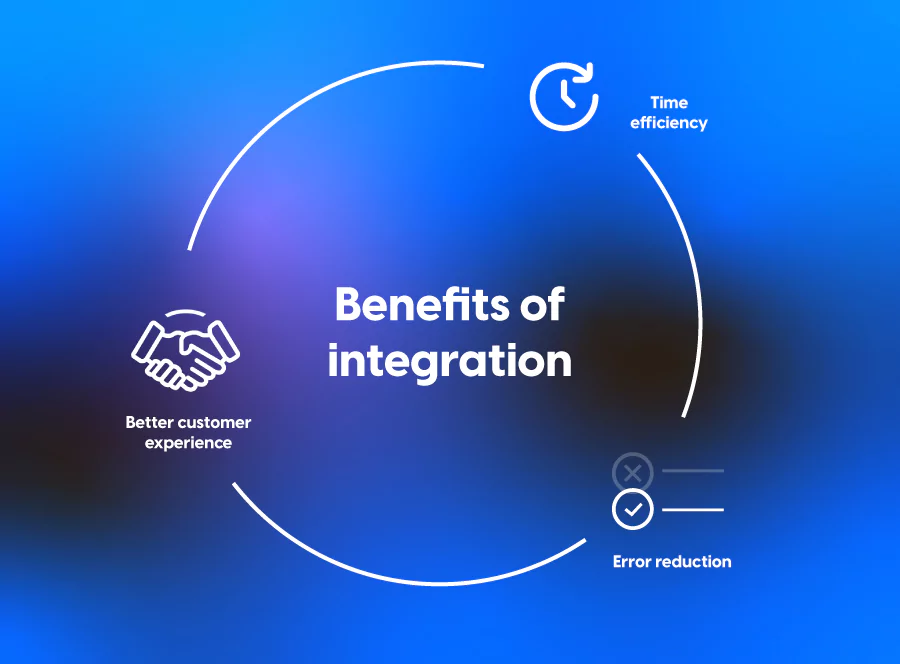
By automating repetitive tasks and integrating different tools in your workflows, you’ll find that your digital catalogs become more efficient to produce. They are also more impactful for your business, allowing your team to focus on higher-value tasks.
Here are some key benefits:
1. Time efficiency
Automation eliminates the need to manually update product information or track orders, allowing you to focus on more important tasks. Integrating your catalog with your existing tools ensures that updates sync across the board without any additional effort.
2. Error reduction
When humans handle data manually, there’s always a risk of error. Automating these processes ensures that data is accurate and consistent, while integration guarantees that changes in one platform are reflected in another, minimizing discrepancies.
3. Better customer experience
Your customers expect up-to-date information, quick responses, and seamless interactions. Automated updates ensure that your catalog always reflects the latest product offerings, while integration with tools like CRMs and email marketing platforms helps create a smooth customer journey, from inquiry to purchase.
For example, Melissa & Doug, a leading children’s toy manufacturer renowned for its timeless, high-quality products, faced challenges in efficiently managing their extensive product catalog. When their Specialty Sales Team integrated Flipsnack into their catalog creation process, the results were significant for their business growth.
By using automation features, they were able to:
- Seamlessly populate their catalog with up-to-date information across 700 products.
- Reduce the time spent on catalog creation by more than 50%.
- Ensure their digital catalogs are always accurate and aligned with the latest offerings.
The success of Melissa & Doug demonstrates the transformative power of automation digital catalog management optimization, especially for businesses with large product lines. By optimizing their process, they were able to focus more on product innovation and customer engagement, rather than letting constant catalog updates overwhelm them.

Integration with Zapier through Flipsnack
Flipsnack offers integration with various tools to streamline processes, saving time and reducing manual effort. Automating tasks across different scenarios can make catalog management more efficient and effective.
One of the best ways to bring automation and integration to life is through Zapier, an automation tool that connects different apps so they can “talk” to each other. It allows you to set up workflows (called “Zaps”) that trigger actions in one app when something happens in another.
By integrating with Zapier, you can easily automate several processes in your digital catalog management, making your workflow smoother and more efficient.
3 ways to use Zapier to help you streamline your selling process
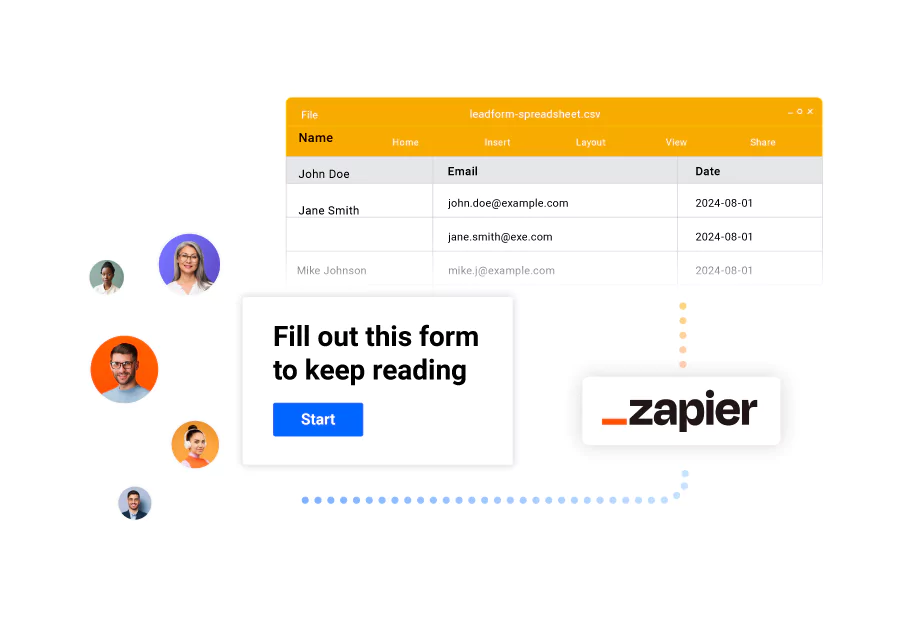
1. Real-time order tracking
If you are a retailer and you manage shopping list orders through your digital catalogs, automating the process with Google Sheets through Zapier can be a real help. Automating the process with Google Sheets, through Zapier can be a real help., for optimizing your digital catalog. Every time a customer places an order using your Flipsnack catalog, Zapier can automatically transfer that data to a Google Sheets document, providing you with a real-time overview of all your orders in one place and ensuring that you don’t miss any orders.
2. Instant lead capture and simplified follow-up process
If your business relies on lead generation forms, you can streamline workflows using Zapier. You can automate lead form submissions to manage leads more efficiently by embedding lead forms directly into your flipbooks. When a customer fills out the form, Zapier automatically sends the data in real time. The data goes to Google Sheets for tracking or to a CRM like HubSpot. This makes it easier for you to follow up with your customers.
3. Understand better your customers’ behavior and preferences
By centralizing all your trackable link data in one place, you streamline access and analysis of key metrics, gaining valuable insights into how your customers interact with your catalog. You can integrate these links with Google Sheets through Zapier, and you can automatically capture essential data, such as click counts, time spent on specific pages, and the popularity of individual products. Making use of this information allows you to make informed improvements to your catalog based on real user behavior. This example is just a way, that Flipsnack’s integration capabilities can be tailored to meet the specific needs of your business, whether in retail, wholesale, or another industry. You can get creative and see what other integration options could benefit your business.

Frequently asked questions
Integration tools are software applications that enable seamless data exchange between different systems and platforms. They consolidate data from various sources into a unified system, helping organizations streamline operations and make informed decisions. Common integration tools include data integration tools, API tools, EAI tools, middleware, and connectors. Each serves specific integration needs.
Integrated automation refers to software workflows that run autonomously with minimal human intervention after you set the initial parameters.
1. Increased efficiency: Automation eliminates repetitive tasks, allowing your team to focus on more valuable work.
2. Cost savings: By reducing the need for manual labor, automation lowers operational expenses and optimizes resource allocation.
3. Improved data accuracy: Automation ensures consistent system updates, minimizing errors and maintaining data integrity.
4. Better customer experience: Automated processes make faster, more personalized service possible, leading to better customer satisfaction.
Conclusion
Automation and integration are powerful tools that significantly improve digital catalog management optimization. Consequently, by simplifying repetitive tasks and providing accuracy across platforms, you’ll save time and improve the overall customer experience. Tools like Flipsnack and Zapier offer seamless integration, making it easier to update catalogs, track orders, and understand your customers’ preferences.

With the right setup, you can transform your workflow, allowing your team to focus on more strategic tasks that drive growth. Explore Flipsnack’s Zapier integration today, and take the first step toward creating a more efficient, error-free, and customer-friendly catalog experience.

